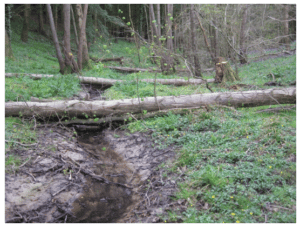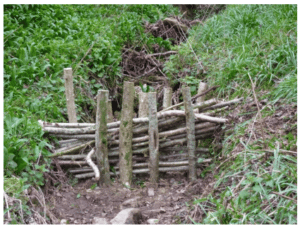Summary of requirements
The following works require ordinary watercourse consent from the Lead Local Flood Authority (Devon County Council) under Section 23 of the Land Drainage Act 1991:
- a) erect any mill dam, weir or other like obstruction to the flow of any ordinary watercourse or raise or otherwise alter any such obstruction; or
- b) erect a culvert in an ordinary watercourse, or
- c) alter a culvert in a manner that would be likely to affect the flow of an ordinary watercourse.
What requires consent?
Any Natural Flood Management (NFM) works that take place within the channel of an ordinary watercourse, including certain works to the banks. Examples of NFM works requiring consent are:
- Leaky dams
- Ditch blocking
- Online attenuation storage ponds (directly controlling the flow of an ordinary watercourse)
- Floodplain reconnection
- Any works that divert or restrict/control flow


If you are unsure whether the works require consent, please contact us with a plan of the works: floodrisk@devon.gov.uk.
Things to consider when applying for Land Drainage Consent
- Do you have landowner permission?
- Do you have the agreement of any adjacent landowners?
- Is a dry working area required? Does the water need to be over pumped or flumed?
- Is there downstream dependence on the water and flows?
- Pollution control measures (for example, a straw bale downstream to trap any disturbed sediment)
- When will work take place?
- How long will works last (a day or weeks etc.)?
- Any environmental/wildlife/fisheries assessments required? Please visit Devon County Council’s Wildlife and Geology website for further guidance.
- Any cultural/archaeological/landscape assessments required? Please visit Devon County Council’s Historic Environment website for further guidance.
- Is planning permission required for large groundworks? Contact your local planning authority for guidance.
- Who will be responsible for maintenance of the structures?
- Are there any structures immediately downstream which could become blocked if the NFM measures become dislodged? A 10m (or 30 times channel width) buffer zone is recommended.
Fisheries
- In order to avoid fish spawning times, any temporary or permanent works being undertaken within ordinary watercourses must avoid the period 1st October – 31st May (inclusive). A fisheries habitat assessment must be provided and approved by the Environment Agency for any works proposed to be carried out within the fish spawning period.
- All works to permanently wet ordinary watercourses should maintain base flow to allow for fish passage. For applications that do not provide provision for fish passage, the Environment Agency fisheries team will be consulted.
Documents to submit
- Overview and location plan.
- Photographs of the ordinary watercourse/ditch.
- Design/Drawing of the works – including cross sections (can use standard cross section drawings, where appropriate i.e. FWAG diagrams), how materials will be secured in place, distance between structures.
- Method Statement – This should include a step-by-step process of how the works will be undertaken, detailing how the water will be managed during the construction work (i.e. over pumped, sandbags etc.), and suitable pollution control measures (i.e. straw bales).
Useful links
DCC Natural Flood Management Guide
Land Drainage Consent application form – Download the application form or apply online.